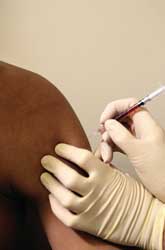What is a Trigger Point Injection?
Trigger point injections are the most common procedures for pain in children and young adults.
What is a trigger point injection?
A trigger point is a “knot” in a tight band of muscle that can be very painful and limit the motion of the muscle where it is found. Trigger point injection is an injection of medication into a tight bundle of muscles called trigger points. The doctor is able to find these painful muscles during an exam.
Why are trigger point injections done?
In some cases, muscle tightness continues and does not respond to usual treatments such as ice / heat, physical therapy or muscle relaxants. To help relax the muscle, it is injected with either a local anesthetic (numbing medicine) or a combination of a local anesthetic medication and a steroid medication.
How is a trigger point injection done?
- The procedure is usually done in the doctor's office.
- The doctor finds the trigger points with the help of the patient.
- The skin over the injection site will be cleaned with chlorhexidine or alcohol, and a small needle will be inserted into the trigger point.
- Up to four trigger points are usually treated in a session. Sometimes more are done, but since they can be painful, the number may be limited for comfort.
It is very important for the patient to tell the doctor when the needle contacts the painful area, as this is where they will inject the medicine. The discomfort will be very temporary.
What are the complications of a trigger point injection?
There are several possible complications; however, the risk is extremely rare. These include, but are not limited to, mild skin irritation, mild bleeding, and infection or injury to underlying tissues.
What to expect after the trigger point injection
The pain may get worse at first. This happens because placing a needle into an irritated muscle causes more irritation. The doctor may recommend a small amount of pain medication for the first two days until the injected medication begins to work. People often report increased mobility of the muscle right away, which is a positive sign. The pain should begin to decrease about two days after injection. Your child can return to normal activities the following day.
When to call the doctor
Call the doctor if your child has a fever and has redness at the injection site.




